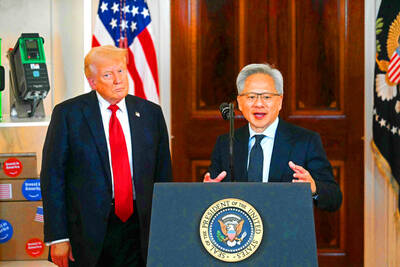CTBC Bank (中國信託商銀) was the only bank among the nation’s six “domestic systemically important banks” (D-SIB) that retained a capital adequacy gauge above the minimum requirements as of the end of June, data released last week by the Financial Supervisory Commission showed.
Five other D-SIBs failed to meet the requirements of 11 percent for a common equity tier-1 ratio, 12.5 percent for a tier-1 capital ratio and 14.5 percent for capital adequacy ratio, as set by the regulator due to the effects of volatile financial markets, the commission said.
CTBC’s common equity tier-1 ratio, tier-1 capital ratio and capital adequacy ratio stood at 11.7 percent, 13.29 percent and 15.15 percent respectively at the end of June, commission data showed.

Photo courtesy of CTBC Bank Co
These gauges provide regulators and investors with the information required to estimate whether a bank can withstand financial stress. To meet higher requirements, a bank usually boosts its core capital or reduces its loans.
The other five banks are Taipei Fubon Commercial Bank (台北富邦銀行), Cathay United Bank (國泰世華銀行), Mega International Commercial Bank (兆豐銀行), Taiwan Cooperative Bank (合庫銀行) and First Commercial Bank (第一銀行).
The commission said the five banks saw some or all of their capital gauges fall below the minimum requirements because of higher risk-weighted assets such as mortgages, or due to falling core capital like shareholders’ equity or retained earnings, it said, adding that banks should promptly improve their capital standards.
Banks in Taiwan reported an average common equity tier-1 ratio of 10.8 percent, tier-1 capital ratio of 12.03 percent and capital adequacy ratio of 14.22 percent at the end of June.

Taiwan Semiconductor Manufacturing Co (TSMC, 台積電) last week recorded an increase in the number of shareholders to the highest in almost eight months, despite its share price falling 3.38 percent from the previous week, Taiwan Stock Exchange data released on Saturday showed. As of Friday, TSMC had 1.88 million shareholders, the most since the week of April 25 and an increase of 31,870 from the previous week, the data showed. The number of shareholders jumped despite a drop of NT$50 (US$1.59), or 3.38 percent, in TSMC’s share price from a week earlier to NT$1,430, as investors took profits from their earlier gains

AI TALENT: No financial details were released about the deal, in which top Groq executives, including its CEO, would join Nvidia to help advance the technology Nvidia Corp has agreed to a licensing deal with artificial intelligence (AI) start-up Groq, furthering its investments in companies connected to the AI boom and gaining the right to add a new type of technology to its products. The world’s largest publicly traded company has paid for the right to use Groq’s technology and is to integrate its chip design into future products. Some of the start-up’s executives are leaving to join Nvidia to help with that effort, the companies said. Groq would continue as an independent company with a new chief executive, it said on Wednesday in a post on its Web

CHINA RIVAL: The chips are positioned to compete with Nvidia’s Hopper and Blackwell products and would enable clusters connecting more than 100,000 chips Moore Threads Technology Co (摩爾線程) introduced a new generation of chips aimed at reducing artificial intelligence (AI) developers’ dependence on Nvidia Corp’s hardware, just weeks after pulling off one of the most successful Chinese initial public offerings (IPOs) in years. “These products will significantly enhance world-class computing speed and capabilities that all developers aspire to,” Moore Threads CEO Zhang Jianzhong (張建中), a former Nvidia executive, said on Saturday at a company event in Beijing. “We hope they can meet the needs of more developers in China so that you no longer need to wait for advanced foreign products.” Chinese chipmakers are in

POLICY REVERSAL: The decision to allow sales of Nvidia’s H200 chips to China came after years of tightening controls and has drawn objections among some Republicans US House Republicans are calling for arms-sale-style congressional oversight of artificial intelligence (AI) chip exports as US President Donald Trump’s administration moves to approve licenses for Nvidia Corp to ship its H200 processor to China. US Representative Brian Mast, the Republican chairman of the US House Committee on Foreign Affairs, which oversees export controls, on Friday introduced a bill dubbed the AI Overwatch Act that would require the US Congress to be notified of AI chips sales to adversaries. Any processors equal to or higher in capabilities than Nvidia’s H20 would be subject to oversight, the draft bill says. Lawmakers would have